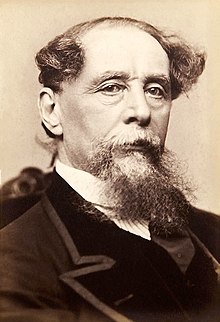
Back Charles Dickens Afrikaans Charles Dickens ALS ቻርልስ ዲከንስ Amharic Charles Dickens AN تشارلز ديكنز Arabic تشارلز ديكنز ARY تشارلز ديكينز ARZ চাৰ্লছ ডিকেন্স Assamese Charles Dickens AST Charles Dickens AVK
Charles Dickens | |
|---|---|
 Portrait by Jeremiah Gurney, c. 1867–1868 | |
| Born | Charles John Huffam Dickens 7 February 1812 Portsmouth, Hampshire, England |
| Died | 9 June 1870 (aged 58) Higham, Kent, England |
| Resting place | Poets' Corner, Westminster Abbey, England 51°29′57″N 0°7′39″W / 51.49917°N 0.12750°W |
| Occupation | Novelist |
| Notable works | |
| Spouse | |
| Partner | Ellen Ternan (1857–1870, his death) |
| Children | |
| Signature | |
 | |
Charles John Huffam Dickens (/ˈdɪkɪnz/; 7 February 1812 – 9 June 1870) was an English novelist, journalist, short story writer and social critic. He created some of literature's best-known fictional characters, and is regarded by many as the greatest novelist of the Victorian era.[1] His works enjoyed unprecedented popularity during his lifetime and, by the 20th century, critics and scholars had recognised him as a literary genius. His novels and short stories are widely read today.[2][3]
Born in Portsmouth, Dickens left school at age 12 to work in a boot-blacking factory when his father John was incarcerated in a debtors' prison. After three years, he returned to school before beginning his literary career as a journalist. Dickens edited a weekly journal for 20 years; wrote 15 novels, five novellas, hundreds of short stories and nonfiction articles; lectured and performed readings extensively; was an indefatigable letter writer; and campaigned vigorously for children's rights, education and other social reforms.
Dickens's literary success began with the 1836 serial publication of The Pickwick Papers, a publishing phenomenon—thanks largely to the introduction of the character Sam Weller in the fourth episode—that sparked Pickwick merchandise and spin-offs. Within a few years, Dickens had become an international literary celebrity, famous for his humour, satire and keen observation of character and society. His novels, most of them published in monthly or weekly instalments, pioneered the serial publication of narrative fiction, which became the dominant Victorian mode for novel publication.[4][5] Cliffhanger endings in his serial publications kept readers in suspense.[6] The instalment format allowed Dickens to evaluate his audience's reaction, and he often modified his plot and character development based on such feedback.[5] For example, when his wife's chiropodist expressed distress at the way Miss Mowcher in David Copperfield seemed to reflect her own disabilities, Dickens improved the character with positive features.[7] His plots were carefully constructed and he often wove elements from topical events into his narratives.[8] Masses of the illiterate poor would individually pay a halfpenny to have each new monthly episode read to them, opening up and inspiring a new class of readers.[9]
His 1843 novella A Christmas Carol remains especially popular and continues to inspire adaptations in every creative medium. Oliver Twist and Great Expectations are also frequently adapted and, like many of his novels, evoke images of early Victorian London. His 1853 novel Bleak House, a satire on the judicial system, helped support a reformist movement that culminated in the 1870s legal reform in England. A Tale of Two Cities (set in London and Paris) is regarded as his best-known work of historical fiction. The most famous celebrity of his era, he undertook, in response to public demand, a series of public reading tours in the later part of his career.[10] The term Dickensian is used to describe something that is reminiscent of Dickens and his writings, such as poor social or working conditions, or comically repulsive characters.[11][12]
- ^ Black 2007, p. 735.
- ^ Mazzeno 2008, p. 76.
- ^ Chesterton 2005, pp. 100–126.
- ^ Grossman 2012, p. 54
- ^ a b Lodge 2002, p. 118.
- ^ "Tune in next week". The New Yorker. 2 December 2017. Archived from the original on 1 December 2017. Retrieved 2 December 2017.
- ^ Ziegler 2007, pp. 46–47.
- ^ Stone 1987, pp. 267–268.
- ^ Hauser 1999, p. 116.
- ^ Cite error: The named reference
Garrattwas invoked but never defined (see the help page). - ^ "Oxford Dictionaries – Dickensian" Archived 26 January 2014 at the Wayback Machine. Oxford University Press.
- ^ "Dickensian meaning in the Cambridge English Dictionary". Cambridge University Press. Archived from the original on 14 July 2018. Retrieved 19 February 2021.